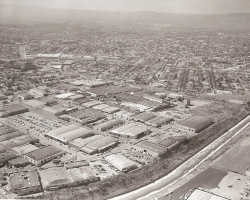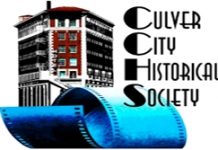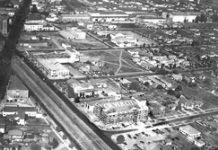
Harry Culver’s dream for a balanced community included an economic base to support its residents. Main Street provided the initial retail and the studios were the early industry. By 1922, the Honers established the first manufacturing plant, Western Stove, on Hays Street (now National Boulevard), north of La Ballona Creek, along the Pacific Electric right of way. The city grew. The early 1930s saw the addition of Helms Bakeries – delivering door to door.
No annexations occurred during the 1930s, a reflection of the Great Depression. Western Stove produced parts for the war effort to survive.
In 1945, the president of the Chamber of Commerce was Adolph Steller, of Steller Hardware. With the end of the war, building was possible again. Steller actively promoted an industrial area, located on former Rancho Rincón de los Bueyes land called the Hayden Tract. Sam Hayden, a transplanted glass manufacturer from the east was the developer. Local newspaper headlines read, “Factories Coming Here in New Development.”
The Hayden Tract abutted Western Stove, which by 1947 was celebrating its silver anniversary and had grown from two small buildings and 20 employees into a manufacturing concern, with 720 employees on 11 acres. By 1949, the 40-acre Hayden Tract was a more than 60-acre-lot subdivision, of “modern reinforced concrete buildings,” according to the Citizen Newspaper, which proclaimed it as “one of the finest in the world.” It was designed to expand Culver City’s economic base. Business owners gave easements on their properties to the railroad for spur tracks, which enhanced the manufacturers’ freight car access to the Pacific Electric Railway.
Sam Hayden filed the Hayden Tract map on March 14, 1946. As with most developments, the streets were named by the developer.
The Hayden Tract enhanced Culver City’s economic base and offered jobs to locals. As the manufacturing plants thrived, so did they wane. A transition occurred as the trains no longer stopped to load and drop goods.
By the early 1990s, the character of the Hayden Tract had changed. Gone were the clothing, plastic, pen and curtain manufacturers, sheet metal shops and Mattel, Inc. Wholesalers moved in, like Freddi’s China Closet and J.J.’s, and La Dijonaise became the cafés of choice. The new wave brought the Willows Private School on Higuera Street, the western boundary of the tract.
Many original buildings deteriorated. The Culver City Redevelopment Agency, established in 1971, turned its attention to the Hayden Tract. Property owners Frederick and Laurie Smith began to redevelop their buildings with noted architect Eric Owen Moss. The revitalization continues to draw noted tenants from the industries of technology, media and entertainment. Most recently, New Yorker Magazine featured the tract with its unusual architecture.
And so, the story of Sam Hayden’s tract continues, and even businesses that were not a part of the original land tract, like the Landmark Industrial tract nearby, (formerly Hal Roach Studios), enjoy the close proximity and name association. And the spirit continues today as Metro’s light rail is being built and the adjacent area redeveloped.
Perhaps the city began branding in the 1930s, as “The Heart of Screenland” appeared on the city seal, but it has continued in the form of planned areas like the Hayden Tract and beyond.













[…] Situated south of Interstate 10, and east of Venice and Marina del Rey, this five-square-mile plot built its reputation as a maker of movie magic (as home to MGM Studios, and the current site of Sony Pictures Studios and Columbia Pictures), and the seat of iconic industry (Hughes Aircraft Company and Hayden Tract). […]